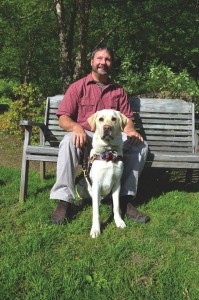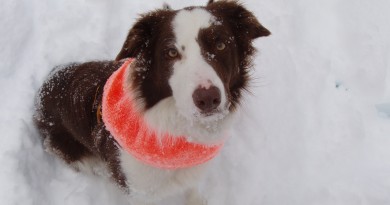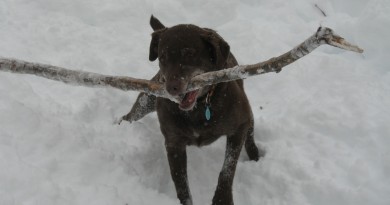Ryan Leads the Way

Eric Caron of Pownal loves to go camping. He has plenty of friends who enjoy going with him, but one of his favorite companions is Ryan, a Labrador retriever. This wouldn’t be particularly noteworthy were it not for the fact that Caron is blind and Ryan is his Seeing Eye dog.
“It doesn’t matter where the campground is or how complicated the layout is,” Caron said. “I show him the path to the office or the bathroom once and that’s all I need to do. After that, he nails it every time.”
Caron relishes the independence this gives him. And it’s the little things that most people take for granted that sometimes mean the most. Without Ryan, he would have to wake up a human travelling companion if he needed to use the restroom, but Ryan will take him there without fail.
Caron, the director of the guidance department at Mt. Anthony Union High School, has been legally blind his entire life, but his vision decreased to light perception by the age of 24. He relied on a white cane for travel until he got Scarlett, his first guide dog.
“Poor Scarlet got stuck with me when I knew nothing about being a guide dog partner,” said Caron. Rather than go to the Guiding Eyes for the Blind training facility in Yorktown Heights, N.Y., Caron and Scarlett trained at his home. “She was amazing,” he recalled, “and we soon branched out from sidewalks to hiking trails.” Caron and Scarlett hiked all over the White Mountains and the Adirondacks. One day in New Hampshire they passed a crew from Animal Planet which was doing a segment on amazing animals. Caron thinks they missed the best story, which was Scarlett leading a blind man up the mountain.
After Scarlett, Caron received a guide dog named Mae, who was also taught at home. Although Mae did her job, she occasionally deviated from the path she was supposed to take.
“My friends said that if Scarlett was a human she would be wearing a cardigan and glasses, but Mae would be wearing a mini-skirt with a devilish gleam in her eye,” Caron explains by way of distinguishes the two personalities.
After Mae retired, he went to the Guiding Eyes training facility and was introduced to Ryan. At first the two-year-old was so quiet Caron wondered if there would ever be an emotional connection between them, but after two weeks he realized he needn’t have worried.
“It was clear that he was really invested,” Caron said. “He figured out quickly that he had a purpose and he totally connected to his job. I think he believes I’m not that bright, so it’s his job to help me.”
Caron described his canine companion as quiet and methodical, but not slow. The pair has a regular route that is roughly four miles, which they complete in a little over an hour, often ending with a jog. “His main purpose is taking care of me,” said Caron. “He’ll go at any pace I want and he’s really happy to move along. I also think I do more with Ryan because having gone to the school, I’m better trained.”
Ryan changes his pace depending on the circumstances. He always walks on Caron’s left so if they are on a trail with a drop-off on the right, Ryan will go slowly. On the way back, with the drop-of on his side, he’ll pick up the pace.
Caron marvels at the fact that in addition to knowing basic commands like right, left, forward and how to stop at a curb, guide dogs are trained to be disobedient when that is required. Caron gave the example of a walk he took through Mt. Anthony recently. At a particular hallway he asked Ryan to turn, but the dog refused.
“I didn’t get upset because he’s a good dog,” remembers Caron, “so I tried again and he still refused.” Caron cautiously reached his hand out and discovered that one side of the hallway had a big dumpster and the other side had a ladder with things perched on it precariously. Although he might have been able to squeeze through the opening, he likely would have knocked something off the ladder.
“That was amazing,” said Caron. “He does the same thing when we’re on the sidewalk and there’s construction tape. He can go under it, but he knows I can’t so he stops.”
Since Ryan needs his exercise, too, the dog is an added incentive for Caron to get outside, allowing him to have a healthier lifestyle. Ryan also makes Caron’s job easier since he is able to leave his office to find students in their classrooms or catch up with them in the hallway rather than have them always come to his office and miss class time.
Guide dogs are trained by a veritable army of almost 1,500 volunteers nationwide who raise puppies from eight weeks to two years before bringing them to Guiding Eyes for the Blind. The dogs generally work for their humans for seven to eight years before retiring.
“These are incredible gifts of love and time,” said Caron. “It costs $50,000 to raise a guide dog. People have gifted me $150,000 so that I could have three dogs. That’s the cost of a house.” Caron considers himself lucky to have been able to keep all his dogs during their retirement years. Retired dogs are often returned to the homes where they were raised.
“The reason I’m allowed to have a dog is safe travel,” said Caron, “but that is only a tiny piece of what this dog does.” Caron noted that if he were to walk into a store with a cane he’d likely be ignored by sales personnel, but that’s not the case with Ryan.
“Since a blind person can’t make eye contact and communicate in the way others take for granted, the dog’s eyes do that for us,” he said.
And thanks to his walks around his neighborhood with Ryan, Caron now feels more fully integrated into the community. “This one Labrador retriever has changed my life,” he said. “Ryan brings me such joy and safety and comfort.”


